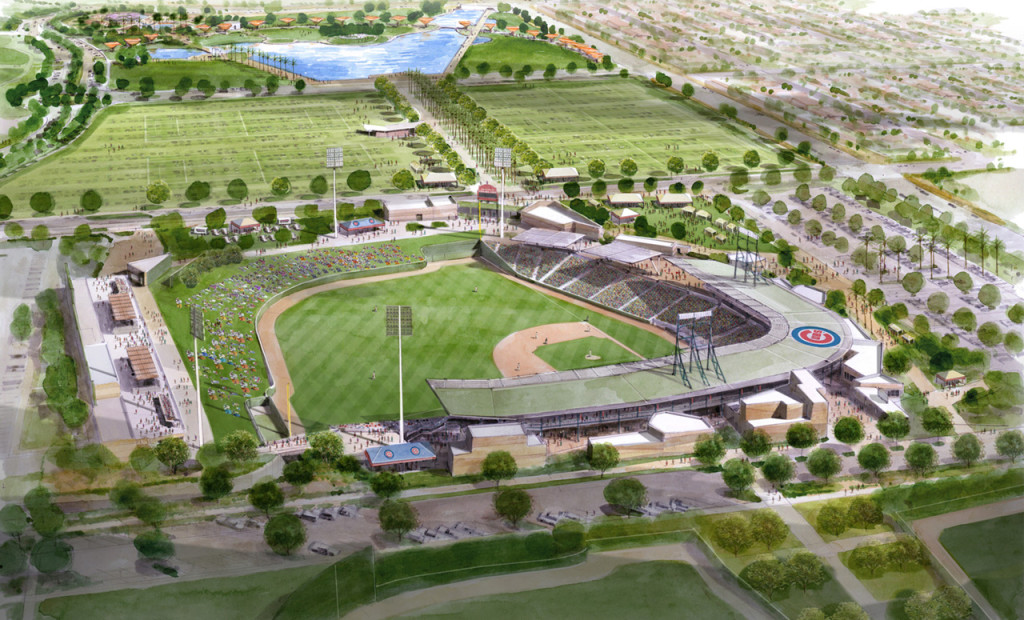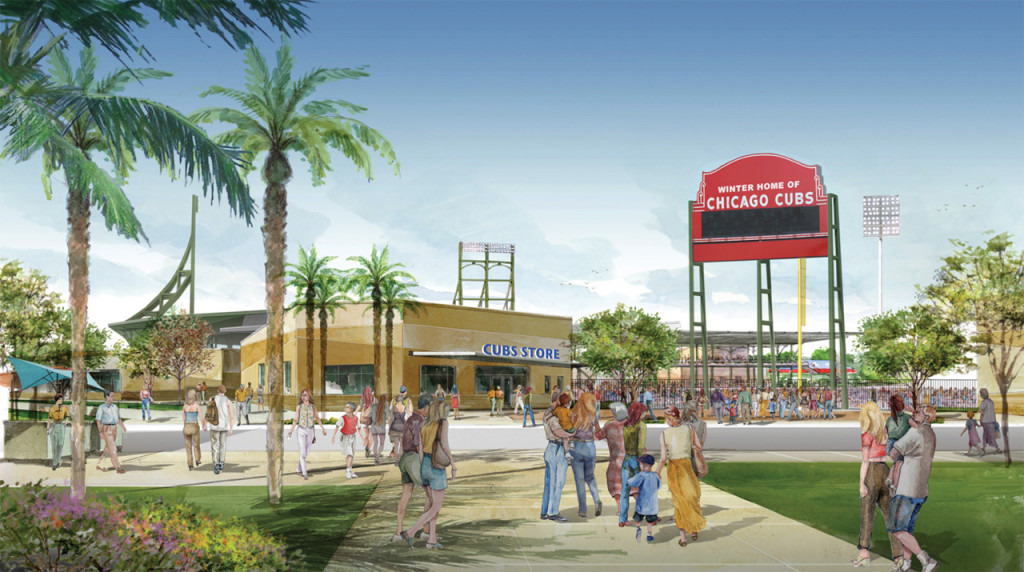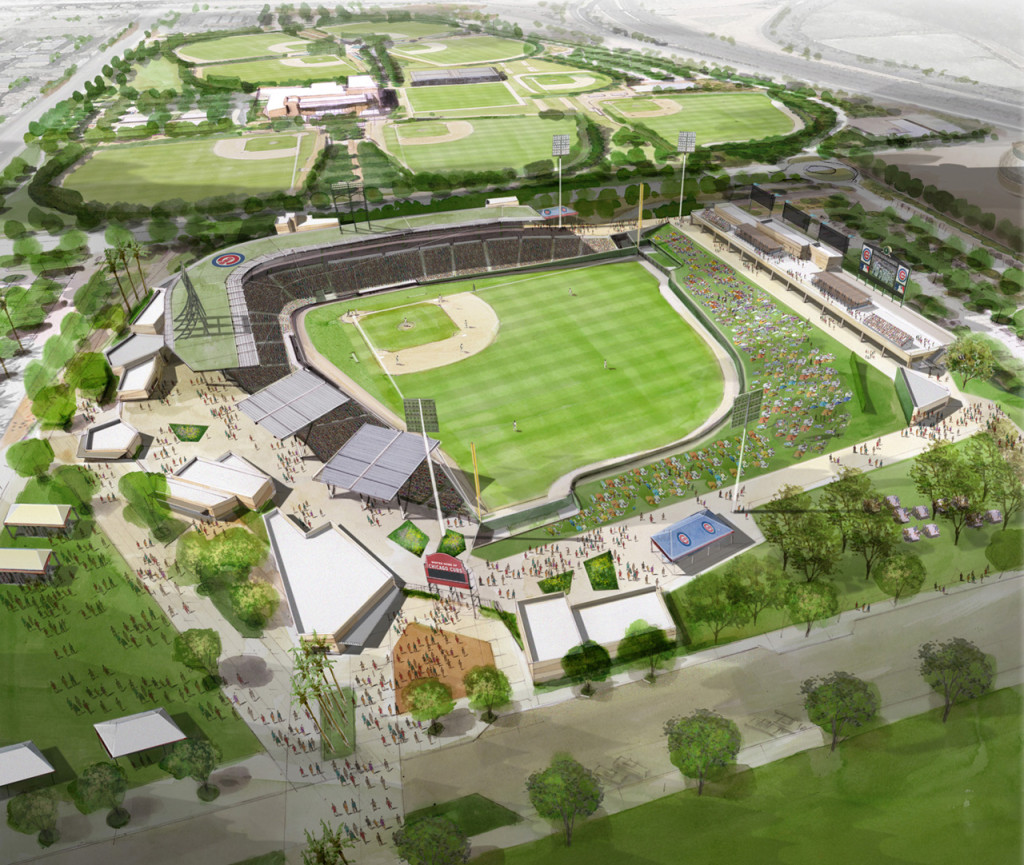With an open design, lots of design references to Wrigley Field and a consolidation of minor- and major-league training facilities, the new Chicago Cubs spring training facility should be popular with both faithful and casual fans.
The Cubs have always been one of the better draws in the Cactus League, attracting healthy crowds to HoHoKam Park. These crowds have already brought in both diehard fans and those attracted to a more casual experience, hanging out on the berm with the likes of Ronny Woo Woo and downing an adult beverage or three. Still, HoHoKam Park wasn’t the friendliest of venues – you were pretty much assured of bad sunburn and a break from the game during a concessions run – and, worst of all where the Cubs were concerned, separate major-league and minor-league training facilities.
These were all issues the Chicago Cubs wanted addressed during the design of the team’s new spring-training facility in Mesa, scheduled to officially open in February as the team’s new Arizona center, though the complex is set to be mostly completed by the beginning of December. For Cubs fans both hardcore and casual, the new training complex should enhance the spring-training experience.
“This is a whole new ballgame for the Cubs – an eye-opening, jaw-dropping experience,” said David Bower, senior partner at Populous, who designed the complex.
Like most new complexes in both the Grapefruit League and Cactus League, the new Cubs complex is spacious and will feature six full practice fields and one half practice field, 12 indoor batting tunnels, and a 70,000-square-foot player-development facility with hydrotherapy pools, classrooms and two-floor exercise room.
For fans, this is all good, but what counts the most is the gameday experience. And this is where Cubs fans will see a huge contrast with HoHoKam Park. Instead of being greeted by a cemetery or a rundown neighborhood, fans accessing the facility will be greeted by a park-like setting, walking through the spine of the complex before reaching the major-league ballpark. They may even take in a morning of fishing at adjacent Riverview Park. It’s a new experience for Cubs fans – which is one of the major points of the new complex for the Cubs ownership and management, Bower said.
“For the fans, it sets what we’ve wanted to do: create a brand-new image for the Cubs,” he said. “It sets a whole new mark for them under new management and ownership.”
Populous did the last major renovation of HoHoKam Park. “That was one of the first times we designed a 360-degree concourse,” Bower said of the feature now found in virtually every new major- and minor-league ballpark, also present in the new Cubs ballpark. Apart from that, there will be very few similarities between the spring ballparks, with the new Mesa facility taking design cues from Wrigley Field.
“We’ve designed the ballpark on the left-field side to resemble the rooftops across from Wrigley Field,” Bower said. “Fans will see Wrigley brought to Mesa in that there’s a lot of light gauge steel, trusses, brickwork and other ornamentation.”
And Wrigley enhanced. Instead of the cramped, under-the-bowl concourses found both at HoHoKam Park and Wrigley Field, the new spring-training ballpark features wide concourses and plenty of points of sale where the action is in plain view. The comfort is extended to the grandstand, where there is plenty of relief from the sun: 70 percent of the seating bowl will be shaded at 2 p.m., according to Bower.
The official capacity is 15,000: 9,200 chairback seats, 4,200 in the outfield berm seating, 1,600 in suite-level seating. The key here was to build capacity without putting in fixed seating: fans will be expected to roam the ballpark and move between party decks and other group spaces. The party atmosphere at HoHoKam Park will certainly export well to the new ballpark.
And the one thing from Wrigley that couldn’t be replicated in the new ballpark? No ivy on the outfield wall. That’s something that could not be imported from Wrigleyville.
Renderings courtesy city of Mesa.




Comments are closed.